The hip joint is where the thigh joins the pelvis. The articulation is designed to provide any direction of movement of the foot. This feature causes the possibility of various damages. The problem causes pain in the hip joint.
The components of articulation undergo painful changes.
Features of the causes of pain
Injuries
When there is pain in the hip joint, legs and hips, the cause of the pathology may be:
- Congenital dislocation due to a failed birth. Injuries are diagnosed immediately in newborns. There are noticeable uneven curves in the baby's hips and shortening of the legs. Often there is a compressed nerve.
- Traumatic dislocation. It is characterized by pain when moving the foot to the side, it is impossible to stand or sit. Hematoma and swelling develop in the joint area. Hip dislocation requires immediate treatment of the victim.
- Neck fracture. The diagnosis is more common in women over 60 years of age. The provocateur of what hurts the right thigh in women is a banal drop. There is a sharp pain that increases with fracture and movement. Gives a very unpleasant discomfort in the thigh. The damaged area swells, bruises appear on the joint. The damaged limb shortens, lameness develops. If the injury compresses a nerve, the hip is numb.
- Joint injury. The pain is moderate, but increases with active movement. Symptoms disappear in a static position. Such an injury is typical for people who are prone to falls. The victim is lame, but the situation passes quickly.
- Perforated fracture. The pain is moderate or severe. The movement aggravates the symptom. Probably a pinched nerve, it hurts, the joints ache.
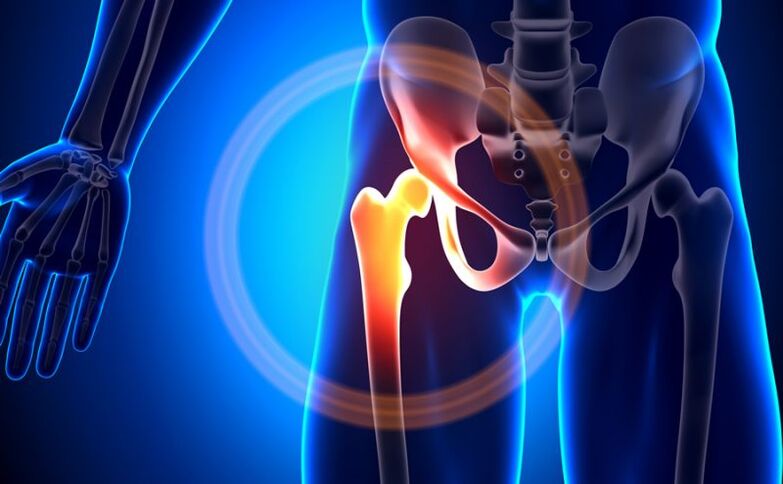
Traumatic injuries are a common cause of low back pain in the pelvis. Serious fractures or dislocations often require surgical intervention. If a nerve is constricted, the leg begins to numb - hurry to the doctor immediately.
Systemic diseases
Joint pain can lead to systemic pathologies of connective tissue. Such diseases require constant treatment, as they are practically incurable. Treatment is complex and should affect the cause of the disorder.
Such diseases can cause pain:
- Bechterew's disease. The pain is dull, getting worse at night. More often pelvic bones ache, spread to the knees, groin, buttocks. It is difficult to move, people are bored. Inflammation develops inside the joint.
- Reiter syndrome. The disease is characterized by damage to the genitourinary system, joints and inflammation of the conjunctiva. Pathology refers to autoimmune diseases that develop due to intestinal infection. Pain in the groin, which spreads to the groin area, begins to be felt a few weeks after infection. The pain syndrome is acute, the temperature rises. The pelvic region is swollen. The disease often causes symmetrical damage to the joints.
- Rheumatoid arthritis. The problem is characterized by inflammation of the connective tissue. It never purulent with pathology. The disease is a harbinger of coxarthrosis. In the beginning, there is swelling, shooting pain, discomfort while walking. The temperature inside the joint rises, then the stiffness of the movements develops. Significant pain in the hip joint extending to the side at night. The pathology manifests itself both on the right and on the left. Nerves are constricted due to the destruction of the joint.
Degenerative changes
Causes of pain in the hip joint and, quite sharply, pulling or burning, are degenerative changes due to such diseases:
- Varus juvenile deformity. There is a dull pain in the knee. Exercise increases the intensity of the syndrome.
- Coxarthrosis. The pathology is diagnosed in people of both sexes. It is treated for a long time and the therapy is very complicated. The disease is characterized by the development of degenerative and destructive processes in the joint. Symptoms: The patient has joint pain as a result of long walks, jogging or climbing stairs. In other cases, the anxiety passes. Then the inside of the thigh hurts, the pain is transferred to the groin area. Daily exercise greatly increases the feeling, but at rest the anxiety disappears. After a long walk, he becomes lame and starts clicking together. Muscle tone deteriorates, tendons malfunction. With an advanced stage of the disease, very severe pain is observed at night, and lameness is already pronounced. Inactivity develops as muscle atrophy, losing volume. Therapy can stop joint destruction.
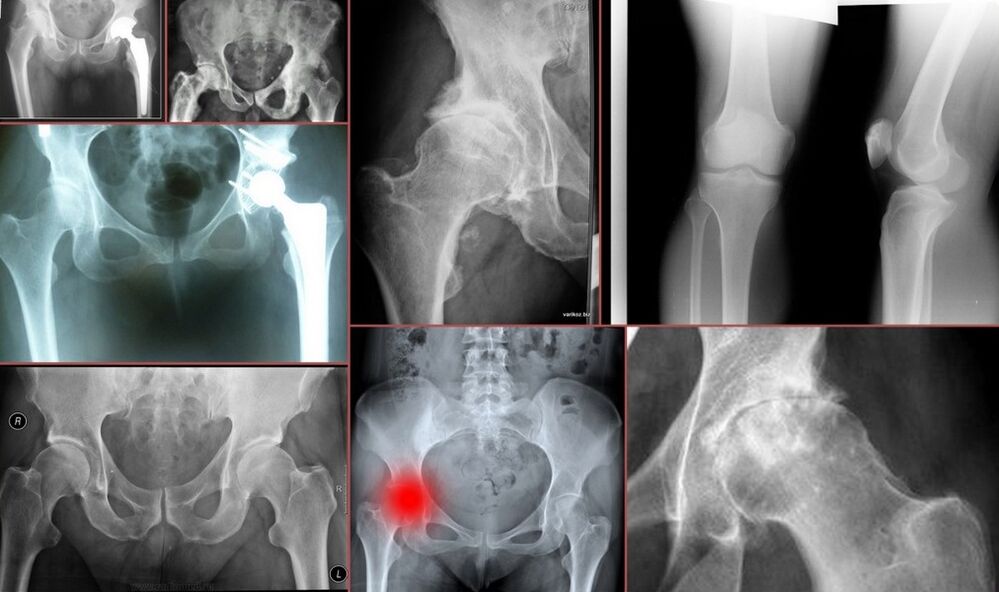
Such diseases cause permanent disability, as a result of which a person is limited to work and can not train fully. It's so hard to get out of bed in the morning.
Inflammatory or infectious causes
In addition to direct damage to the joint, inflammation of the articular sac, tendons, or muscles can cause discomfort. Infectious diseases also cause pelvic pain in women and men:
- Tuberculosis arthritis. The pathology mainly affects young children with weakened immune systems. The child gets tired quickly, runs a little. Thigh muscles begin to atrophy, legs shorten, joint clicks. Gradually, severe pain syndrome develops in the affected joint. Sometimes the pain is sharp, but more often it is burning or tingling. Later, pus forms in the joint, which increases the symptoms.
- Purulent arthritis. With such a disease, the temperature rises, the skin around the joint becomes red, there is swelling, and there is a sharp or sharp pain. Any load (banal getting out of bed) is painful. The pain passes. Therapy cannot be delayed because a person develops sepsis.
- Bursitis is an inflammation that affects the joint sac. The main symptom is pain in the soles of the feet. It's sharp, and when you get up, the anxiety increases. When the limb is not loaded, the pain only burns.
- Aseptic necrosis of the femoral head. Most pathologies develop in young men. Circulation in the hip joint causes the disease to worsen. Tissue cells die as a result of necrosis. The disease is characterized by sharp pain in the groin area, a strong burning sensation in the affected area. It hurts so much that the young man loses the ability to lean on his feet, it is difficult to get out of bed in the morning. Often only one analgesic injection helps the patient. After a few days, the pain symptoms disappear. As the pathology progresses, changes occur in the atrophied tendons and muscles. Walking disorder develops due to lameness.
Infectious pathologies develop various pains: burning, dull or tingling sensations. Anxiety increases so much that it interferes with sleep at night. Any disease requires immediate treatment.
Treatment
Hip pain should be treated, even at intervals. Therapies depend on the provocateurs of the symptom.
congenital dislocation
When the dislocation is congenital, the baby is placed together with orthopedic products: supports, stirrups, it is recommended to use a Freik pillow. Such devices help to keep the limbs in a physiological state. The baby should be in this condition for at least six months.
When traditional treatment fails, the baby needs surgery. Surgically, the head of the bone is replaced in the newborn, while other defects are corrected. When the orthopedic devices are already removed, the child is given a light massage to strengthen the muscles.
Traumatic dislocation
In the event of a traumatic dislocation, the doctor will prescribe medication to relieve muscle tone and then replace the hip. After that, the patient should be sedated. If there is numbness in the limb, it means that the nerve is constricted. In this case, you can not do without an examination by a neurologist.
Bechterev syndrome
Treatment of Bechterew's disease is carried out in a complex way. This helps to reduce the intensity of the symptoms caused by the inflammatory process. Treatment consists of medication (immunosuppressants, hormonal drugs, anti-inflammatory drugs), physiotherapy and therapeutic exercises (muscle stretching is especially useful). Recommended massage of the affected joint.
Preparations along with therapeutic exercises are prescribed only by a traumatologist, surgeon or orthopedist. You need to swim more to strengthen your pelvic muscles. In difficult situations, the patient is prescribed a joint replacement.
Hip fracture
Treatment of such an injury is carried out by a traumatologist. Surgery is recommended because conservative treatment is rarely effective. However, if surgery is not possible, the patient is given a cast from the heel to the lumbar region. In older people, such damage rarely grows together - the recovery process takes months.
Among the consequences of the disease is a decrease in the functionality of the cardiovascular and respiratory systems, as the patient is unable to move normally and lead an active lifestyle. Even sitting is a problem for him.
When the joint is broken, there is a burning sensation inside the soft tissues. During surgery, fixation of the bone body and head with pins or screws is used for treatment, and in difficult cases, endoprosthesis is performed.
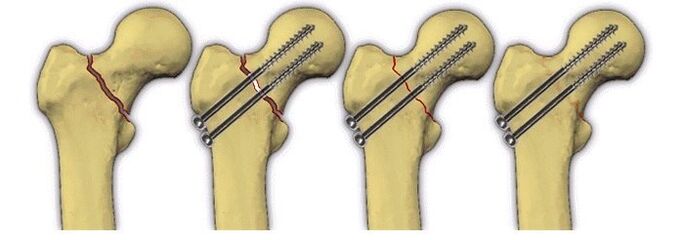
Reiter's disease
Antibiotics, glucocorticosteroids, anti-inflammatory drugs, drugs that weaken the immune system and topical ointments are used to treat Reiter's pathology. Therapy lasts more than four months. Even adequate treatment does not prevent the recurrence of the disease.
Exercise - An entire recovery cycle is required to maintain muscle tone with traditional stretching.
Rheumatoid arthritis
Rheumatoid arthritis is often the cause of hip pain in women and men. Pathology can cause severe pain, it is impossible to get rid of it completely. However, drug treatment should be used to improve quality of life. Hormonal agents, cytostatics, non-steroidal anti-inflammatory drugs, anti-rheumatic drugs are used.
Surgery is used only when the disease progresses, when the patient is practically unable to walk or sit. Recommend fixation of the joint or its arthroplasty. Exercise, local ointments are useful.
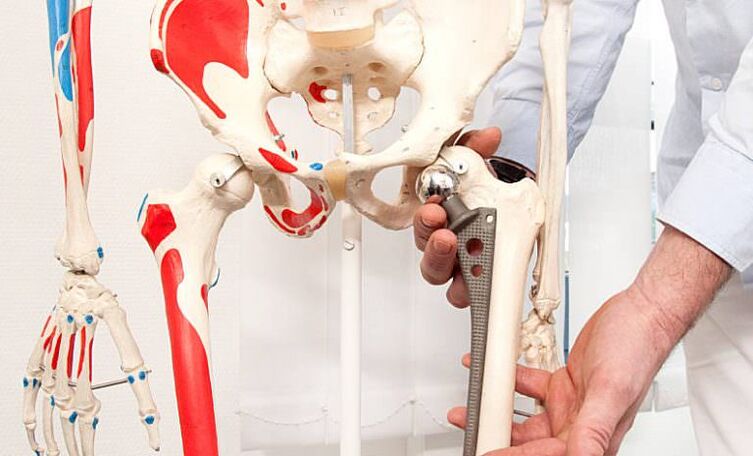
Coxarthrosis
Treatment of coxarthrosis tries to eliminate the causes of unpleasant symptoms. The pathology is initially treated conservatively. The patient is advised to take non-steroidal anti-inflammatory drugs, chondroprotectors, drugs that improve blood circulation.
Warming ointments and painkillers are actively used in treatment. In addition, the patient is recommended to do light therapeutic exercises. Often requires joint anesthesia, so intramuscular injections are used with significant concern.
With advanced disease, conservative therapy does not give the desired effect. Any joint burden worsens the patient's well-being. The patient cannot get out of bed without the help of a stranger. She needs constant painkillers. In this case, only surgery can correct the situation.
Arthroplasty is often performed, but this procedure is contraindicated for the elderly. For this reason, only ancillary operations are organized for such patients. Surgical treatment is supplemented by a course of recovery: minimal stretching, simple exercises performed under medical supervision.
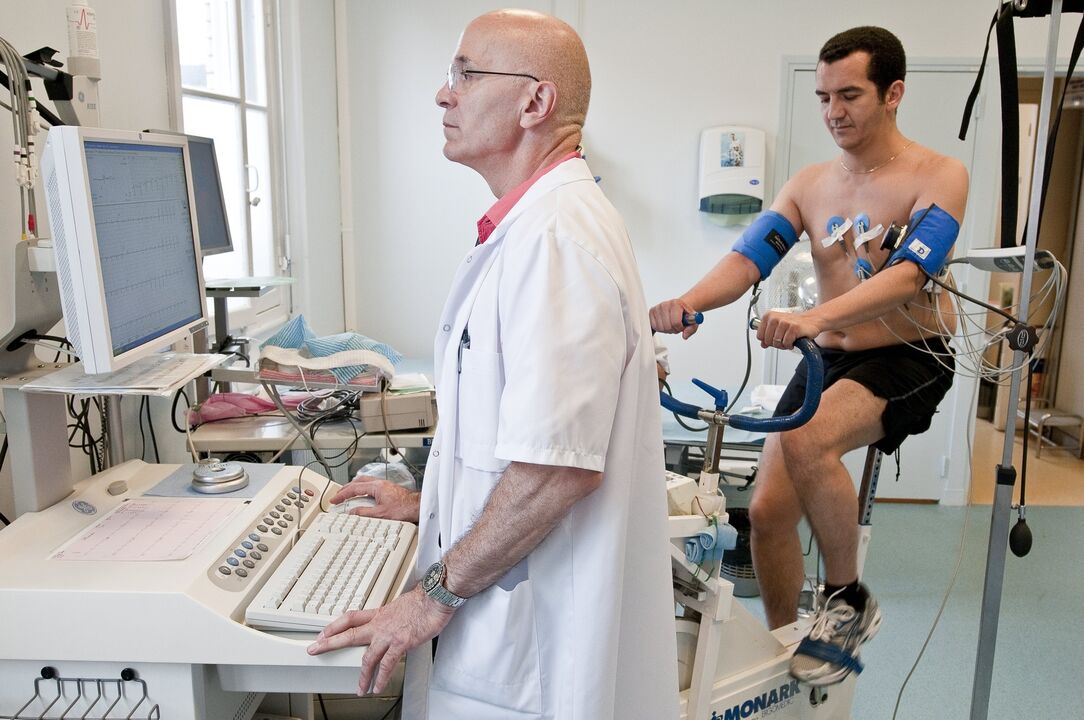
Proper therapy helps to stop the progression of the disease and eliminate the painful symptoms.
Features of the treatment of infectious lesions
If the pain in the hip joint is triggered by an infectious lesion, you should first contact an infectious disease specialist. How to relieve pain in the hip joint with such a pathology? It all depends on the type of disease:
- Tuberculosis arthritis is mainly treated conservatively. The patient is required to restrict mobility by applying a tight bandage. When an abscess forms in the soft tissues, it is surgically removed.
- Purulent arthritis. First, the affected joint is anesthetized. An analgesic intraarticular injection is used for this. Antibiotics and antibacterial drugs are used against infection, while different groups of them are used, only prescribed by a doctor. In addition, abscesses are removed. The affected limb should be immobile - the patient is put on a tire or plaster.
- Treatment of aseptic necrosis includes restoration of poor blood flow, resorption of dead areas. Non-steroidal anti-inflammatory drugs and vitamin complexes, drugs to reduce blood pressure are used to anesthetize the limbs. When there is pain in the thigh, additional anesthetic ointments and massage procedures are prescribed. The disease is still treated with physiotherapy and therapeutic exercises. In complex cases, minimally invasive surgery or joint arthroplasty is used.
- Because bursitis causes severe pain, anesthesia should be arranged. For this purpose, anti-inflammatory drugs and analgesics are used, which are administered intramuscularly. Steroid medications are used to quickly relieve severe anxiety. He needs rest because he is in constant pain.
Joint numbness, burning and pain in the joint that radiate to the surrounding area are unpleasant sensations that indicate the presence of a serious pathology. Sometimes folk recipes help in such a situation.
Alternative treatment
When a patient has severe burning pain, problems with the tendons are noticeable, but his drug use is contraindicated - the use of folk recipes is allowed. Although they are not a panacea, they can help correct the condition with complex therapy. Before using any folk remedy, you must obtain medical permission for such a procedure.
Here are some tips:
- Clay compresses. Such folk remedies help to relieve pain and reduce joint swelling. Clay is recommended as an alternative, first blue, then black. Used at night, wrap the compress with a woolen cloth.
- A homemade ointment made from white foot root and visceral oil. Melt the oil, add the root, first chop with a meat grinder. Put the mixture on low heat. After boiling, keep on the fire for another 7 minutes. Apply the cooled ointment to the affected joint before going to bed. Be sure to insulate the joint. Such a folk remedy perfectly eliminates swelling and other unpleasant symptoms.
- cabbage compresses. You need points with them. Lubricate the cabbage leaf with a bee product, then apply to the painful area. Cover the compress with a plastic bag on top, insulate everything with a woolen cloth. Therapeutic course - one month. It is recommended to give a light massage to the joints at intervals between compresses.
- Lemon, garlic and celery relieve severe pain. To prepare it, take 2 lemons, 130 g of garlic and 300 g of celery. Finely chop the ingredients with a meat grinder, pour into a container with a tightly closed lid. Pour boiling water over everything and mix. Close the lid and wrap the dish in a blanket. After 12 hours, drink 1 tsp liquid. a few months before meals.

It should be remembered that folk remedies can not eliminate the compressed nerve that occurs inside the hip joint. Be sure to consult a neurologist if your limbs are numb. Also keep in mind that any joint injury that causes pain should be identified immediately and treated adequately.
Light gymnastics and stretching exercises are able to prevent joint dysfunction.
































